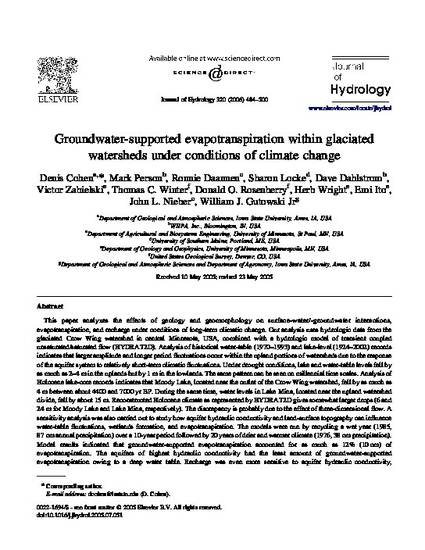
This paper analyzes the effects of geology and geomorphology on surface-water/-groundwater interactions, evapotranspiration, and recharge under conditions of long-term climatic change. Our analysis uses hydrologic data from the glaciated Crow Wing watershed in central Minnesota, USA, combined with a hydrologic model of transient coupled unsaturated/saturated flow (HYDRAT2D). Analysis of historical water-table (1970–1993) and lake-level (1924–2002) records indicates that larger amplitude and longer period fluctuations occur within the upland portions of watersheds due to the response of the aquifer system to relatively short-term climatic fluctuations. Under drought conditions, lake and water-table levels fell by as much as 2–4 m in the uplands but by 1 m in the lowlands. The same pattern can be seen on millennial time scales. Analysis of Holocene lake-core records indicates that Moody Lake, located near the outlet of the Crow Wing watershed, fell by as much as 4 m between about 4400 and 7000 yr BP. During the same time, water levels in Lake Mina, located near the upland watershed divide, fell by about 15 m. Reconstructed Holocene climate as represented by HYDRAT2D gives somewhat larger drops (6 and 24 m for Moody Lake and Lake Mina, respectively). The discrepancy is probably due to the effect of three-dimensional flow. A sensitivity analysis was also carried out to study how aquifer hydraulic conductivity and land-surface topography can influence water-table fluctuations, wetlands formation, and evapotranspiration. The models were run by recycling a wet year (1985, 87 cm annual precipitation) over a 10-year period followed by 20 years of drier and warmer climate (1976, 38 cm precipitation). Model results indicated that groundwater-supported evapotranspiration accounted for as much as 12% (10 cm) of evapotranspiration. The aquifers of highest hydraulic conductivity had the least amount of groundwater-supported evapotranspiration owing to a deep water table. Recharge was even more sensitive to aquifer hydraulic conductivity, especially in the lowland regions. These findings have important implications for paleoclimatic studies, because the hydrologic response of a surface-water body will vary across the watershed to a given climate signal.
Available at: http://works.bepress.com/william-gutowski/45/

This article is from Journal of Hydrology 320 (2006): 484–500, doi:10.1016/j.jhydrol.2005.07.051.